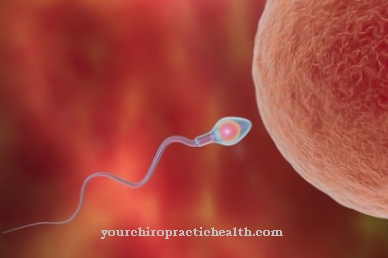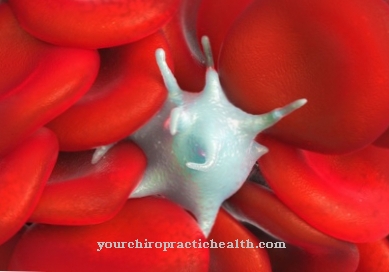The Cholesterol biosynthesis enables the body's cells to synthesize cholesterol from simple raw materials in 18 steps. This biosynthesis takes place primarily in the liver and intestinal walls. Hereditary metabolic diseases such as Tangier's disease can disrupt the biosynthesis of cholesterol.
What is Cholesterol Biosynthesis?

The human body produces its own cholesterol in a biochemical process in 18 different steps. This process is also known as cholesterol biosynthesis. Most of total cholesterol is made by the body. Only a minimal fraction is ingested through food.
Cholesterol is a lipid that is essential for many body functions. In the case of steroid hormone synthesis, for example, the body depends on cholesterol. The same applies to various storage processes and the construction of cell membranes.
The metabolic pathway of cholesterol biosynthesis enables all living things with a cell nucleus to produce the important lipid from simple elements. The body's cholesterol production is regulated as needed. The transformation of the substances takes place in the cytosol and in the endoplasmic reticulum of the cells. Transcription factors regulate the processes and influence the biosynthesis either positively or negatively.
Bloch and Lynen received the Nobel Prize in 1964 for their research into cholesterol metabolism. Popják and Cornforth also made important contributions to research into cholesterol biosynthesis.
Function & task
The human body produces around 700 milligrams of cholesterol every day in biosynthesis and around 150 grams of cholesterol are built into the entire body. Large amounts of the lipid are found primarily in the brain and adrenal glands. Cholesterol fulfills stabilizing functions in cell membranes and is therefore an important building material.
In humans, cholesterol biosynthesis takes place primarily in the intestinal mucosa and the liver. While many cells in the body are able to synthesize cholesterol, the liver still makes most of the cholesterol.
Because the body's cholesterol cannot cross the blood-brain barrier into the brain, the brain has to produce the cholesterol in the central nervous system itself. Cholesterol in the brain makes up around 24 percent of total cholesterol.
The output of cholesterol synthesis is DMAPP, which is produced in the mevalonate metabolic pathway. 18 intermediate stages make up cholesterol biosynthesis. Before synthesis, the body synthesizes acetyl-CoA. This process takes place via the mevalonate biosynthetic pathway. Via HMG-CoA, the starting material acetyl-CoA is converted into mevalonic acid. The end products of the mevalonate biosynthetic pathway are dimethylallyl pyrophosphate and isopentyl pyrophosphate.
Only now does the actual cholesterol biosynthesis begin. The two end products of the meyalonate biosynthetic pathway are combined to form geranyl pyrophosphate. This compound is converted to farnesyl pyrophosphate. Two farnesyl pyrophosphates are involved in a condensation reaction and are transformed into squalene in the course of this reaction. From this (S) -2,3-epoxysqualene are produced, which in turn are converted into lanosterol. The lanosterol takes part in a demethylation. So it becomes 4,4-dimethyl-5α-cholesta-8,14,24-trien-3β-ol.
At this point, several oxidation reactions take place that give rise to 14-demethyllanosterol. The end products of the oxidation are converted into zymosterone via zymosterol carboxylate. This is followed by a reduction in zymosterone, which results in zymosterol. Via 5α-Cholesta-7,24-dien-3β-ol this results in 7-dehydrocholesterol. When this product is hydrogenated, cholesterol is eventually created.
Illnesses & ailments
Various hereditary diseases are known under the name of familial hypercholesterolemia which affect the cholesterol metabolism. Regardless of diet, these disorders result in greatly increased cholesterol levels in the plasma. As secondary diseases, vascular diseases and heart attacks can set in at an early age. The disease is caused by a defect in the gene that codes for the LDL receptor. Because of this defect, the LDL receptor is only incompletely developed or not at all. Above all, the LDL value of those affected is therefore significantly increased. Xanthomas shape the clinical picture. These are fat deposits in the skin, in the internal organs and in the central nervous system.
Hypercholesterolemia does not have to be familial, it can also be acquired. The acquired forms are mainly triggered by malnutrition. Diabetes can be the primary disease. Obesity or chronic kidney failure are also often associated with high cholesterol levels.
In addition to diets, drugs such as CSE inhibitors are used in the treatment of above-average cholesterol. Statins can inhibit cholesterol biosynthesis. Treatment with CSE inhibitors is aimed at this inhibition. They prevent HMG-CoA reductase and thus enable a general lowering of the cholesterol concentration in serum. In this way, for example, the secondary disease arteriosclerosis can be slowed down. Cholesterol-related heart attacks or other concomitant diseases when the cholesterol level is too high can also be prevented with the CSE inhibitor.
Hypocholesterolemias are the opposite of hypercholesterolemias. Low serum cholesterol, as occurs in the context of hypocholesterolemia, is associated in the majority of cases with a malignant cancer. In cancer-related hypocholesterolemia, the low cholesterol level is usually rated as a risk factor for all-cause mortality.
Malnutrition, AIDS or severe infections are other causes of severely low cholesterol levels. However, hypocholesterolemia can also occur as part of a hereditary disease. An example of such is Tangier's disease. Patients with this disease particularly suffer from HDL hypocholesterolemia.













.jpg)

.jpg)
.jpg)











.jpg)